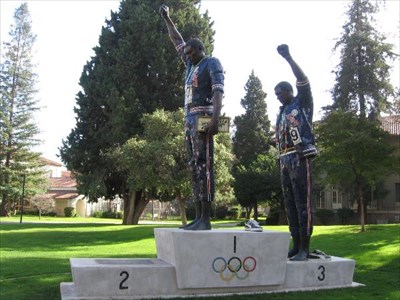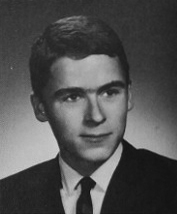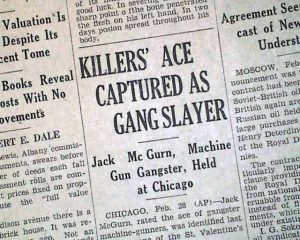1968 was a year of racial division and tragedy. African American’s had discussed the possibility of a boycott of the 1968 Summer Olympics. Dr. Martin Luther King Jr., a huge supporter of this boycott, said he would join Olympians John Carlos and Tommie Smith in Mexico to protest.1 These boycotts slowly fell through the cracks following the assassination of Martin Luther King Jr., and the riots during the Holy Week uprising. These riots were a direct response to the tragic death of MLK. Now that Dr. King would no longer be joining John Carlos in Mexico, other athletes became skeptical in boycotting the Summer Olympics. African American athletes began to change their stance on the boycott. The Olympians decided they would rather compete for themselves and their country, rather than sit out for a protest that would have a lot of attention in the media. But, John Carlos still felt like something needed to be done about the racially divided nation he lived in. With just a few weeks until the 1968 Summer Olympic Games, John Carlos had to decide how he would make his stand without the help or support of other Olympians or the civil rights activist Martin Luther King.2

With just ten days until the opening of the Summer Games, an unarmed group of student protesters gathered in Mexico City’s Three Cultures Square to plan their next step as a movement. The Mexican government sent bulldozers to break up the thousands of people who had gathered there. Mexican troops fired into the crowd, injuring and taking the lives of many people.3
This tragedy was eye-opening for both Carlos and Smith. Being in Mexico helped them to realize that they lived in a world that was unjust for all kinds of people. So the two decided that they needed to make a stand, and to be a voice for the voiceless.4 John Carlos and Tommie Smith knew that if they wanted to make a stand, it was imperative that they compete well enough to end up on the podium for the world to see.
Prior to their races, John Carlos and Tommie Smith decided that they both needed to make the podium together to make their stand through symbolism. The two men decided they would wear black gloves to symbolize strength and unity. They also wore beads around their necks to represent the history of lynching, and they decided to not wear shoes to symbolize black poverty in America.5 John Carlos and Tommie Smith wanted to do this because they felt that something needed to call attention to the broken and discriminated nature of their country. They wanted to make sure people were aware that there were those who lived in the “land of the free” that were far from free in terms of oppression.
The qualifying rounds had finally begun, and Tommie, unfortunately, pulled his groin in the quarter semi-finals. He refused to sit out though. Tommie was determined to compete because, to him, the race was so much bigger than he was, and bigger than anything else happening at the Olympics that summer.6
200m Final | Courtesy of Youtube
The finals had finally arrived. The next twenty seconds would be a defining moment for the two men. The gun sounded and the two flew. Tommie had a slow start but ended up setting a world record with a time of 19.57. John Carlos finished third, bested by Peter Norman by one step. But the two had made the podium, and it was time for them to make their stand. John Carlos told Norman what was about to happen, and Norman placed a button on him that read “We are Olympic Project for Human Rights,” to support the two men he was about to stand with on the podium.7

Carlos and Smith finally got their time on the podium, and as the two men’s fists shot up, 50,000 people fell silent. When the two walked toward the tunnel, following the National Anthem, people began booing and throwing things at them, screaming at them things like “Niggers need to go back to Africa,” and “I can’t believe this is how you Niggers treat us after we let you run in our games.”8 Then, in the midst of all this, the two stopped, threw their fists up again, screamed “right on,” and ran off the track.
The two got on the bus to begin the ride back to Olympic Village, and they got a glimpse of the rude awakening they were about to receive upon returning to the United States. As the two were about to sit down in the bus, a white man shouted: “those are the two that spit on my flag, you must be some kind of Communist.”9 The man continued badgering them until they arrived at Olympic Village.10
As the Olympics progressed, the USA Track team supported Carlos and Smith, and made signs to display throughout the remaining events. Following the United States winning the 4×100 relay finals, the team dedicated their win in an interview to Carlos and Smith. The US Olympic Committee was furious with the negative press that John Carlos and Tommie Smith were receiving for the scene they had caused, and the US Olympic Committee told the US team to either fly home or kick the two men off the team.11
Carlos and his wife were being bothered by the press constantly, and as they were heading to their hotel room one night, Carlos snapped and told the press: “Listen, I’m pretty pissed off with some of you white folk out there. The next one that takes a camera and microphone and sticks it up in my face, I am going to knock you down and act like you stole something.”12 These comments only escalated a situation that was already being blown up in the United States.13
After John Carlos and Tommie Smith returned home, they were suspended from the United States track team for making a scene on international television. And they began receiving death threats from many people.14 They were also being slammed in the media. Reporters called them “Blacked Skinned Storm Troopers,” while comparing their peaceful protest to a “Nazi Salute.”15 So much of the nation was infuriated with what these men had done. Some African Americans had even told them that they “set back black people 100 years.”16 The two refused to let the backlash quiet their message though, and they began speaking at colleges and in cities around the country to discuss equality in America. These men stood for something they believed in and got slandered in the media all over the world.17

Carlos and Smith felt like something needed to be done about the way people treated African Americans in America, and they refused to stand by and be complacent with the slow progress the United States had been making. It was not until 2008 that they received an ESPY award and were recognized in the media for their brave action.18 It’s truly tragic to see how these men were treated following the 1968 Summer Olympics, but it’s inspiring to see people fight and stand for what they believed in to call attention to issues they felt weren’t being adequately addressed in the United States. These men are part of the reason why we have made such great strides in the struggle for equality in America today.
- Erin Blakemore, “How the Black Power Protest at the 1968 Olympics Killed Careers,” History.com, February 22, 2018. Accessed February 14, 2019. https://www.history.com/news/1968-mexico-city-olympics-black-power-protest-backlash. ↵
- John Carlos, The John Carlos Story: The Sports Moment That Changed the World (Chicago, Illinois: Haymarket Books, 2011), 90-97. ↵
- Erin Blakemore, “How the Black Power Protest at the 1968 Olympics Killed Careers,” History.com, February 22, 2018. Accessed February 14, 2019. https://www.history.com/news/1968-mexico-city-olympics-black-power-protest-backlash. ↵
- Erin Blakemore, “How the Black Power Protest at the 1968 Olympics Killed Careers,” History.com, February 22, 2018. Accessed February 14, 2019. https://www.history.com/news/1968-mexico-city-olympics-black-power-protest-backlash. ↵
- John Carlos, The John Carlos Story: The Sports Moment That Changed the World (Chicago, Illinois: Haymarket Books, 2011), 110. ↵
- John Carlos, The John Carlos Story: The Sports Moment That Changed the World (Chicago, Illinois: Haymarket Books, 2011), 111-112. ↵
- John Carlos, The John Carlos Story: The Sports Moment That Changed the World (Chicago, Illinois: Haymarket Books, 2011), 112-113. ↵
- John Carlos, The John Carlos Story: The Sports Moment That Changed the World (Chicago, Illinois: Haymarket Books, 2011), 121. ↵
- John Carlos, The John Carlos Story: The Sports Moment That Changed the World (Chicago, Illinois: Haymarket Books, 2011), 123. ↵
- John Carlos, The John Carlos Story: The Sports Moment That Changed the World (Chicago, Illinois: Haymarket Books, 2011), 123. ↵
- Erin Blakemore, “How the Black Power Protest at the 1968 Olympics Killed Careers,” History.com, February 22, 2018. Accessed February 14, 2019. https://www.history.com/news/1968-mexico-city-olympics-black-power-protest-backlash. ↵
- John Carlos, The John Carlos Story: The Sports Moment That Changed the World (Chicago, Illinois: Haymarket Books, 2011), 124. ↵
- John Carlos, The John Carlos Story: The Sports Moment That Changed the World (Chicago, Illinois: Haymarket Books, 2011), 127. ↵
- John Carlos, The John Carlos Story: The Sports Moment That Changed the World (Chicago, Illinois: Haymarket Books, 2011), 130. ↵
- DeNeen L. Brown, “They didn’t #TakeTheKnee: The Black Power protest salute that shook the world in 1968,” The Washington Post, September 24, 2017. Accessed February 14, 2019. https://www.washingtonpost.com/news/retropolis/wp/2017/09/24/they-didnt-takeaknee-the-black-power-protest-salute-that-shook-the-world-in-1968/?utm_term=.97f6d2d0f51a. ↵
- “Sprinters are Both Suspended Because of Protest,” The Parsons Sun, Kansas, October 18, 1968. ↵
- DeNeen L. Brown, “They didn’t #TakeTheKnee: The Black Power protest salute that shook the world in 1968,” The Washington Post, September 24, 2017. Accessed February 14, 2019. https://www.washingtonpost.com/news/retropolis/wp/2017/09/24/they-didnt-takeaknee-the-black-power-protest-salute-that-shook-the-world-in-1968/?utm_term=.97f6d2d0f51a. ↵
- DeNeen L. Brown, “They didn’t #TakeTheKnee: The Black Power protest salute that shook the world in 1968,” The Washington Post, September 24, 2017. Accessed February 14, 2019. https://www.washingtonpost.com/news/retropolis/wp/2017/09/24/they-didnt-takeaknee-the-black-power-protest-salute-that-shook-the-world-in-1968/?utm_term=.97f6d2d0f51a. ↵



57 comments
Makenzie Santana
I love how this article really captured the important symbolism that the Olympic winners represented in the year of 1968. Racial divinity was still a huge problem at that time in history and it was great to read about these athletes that had this impact in the discriminating times. I love learning more and more about those who played a part in this racial movement.
Samantha Ruvalcaba
Interesting read on what peacefully protesting and fighting for equality looks like. The backlash they received reminds me a lot of the type that NFL players receive today for kneeling. The man in this case accused the finalists for “spitting on [his] flag,” whereas today it’s more like “disrespecting the flag and the US troops.” Just comes to show that there is a lot more progress to make.
Vanessa Sanchez
I love reading about articles where people prove others wrong specially for something as big as racism. Even though racism was such a huge deal and having people excluded from activities. They pushed and become the greatest. Thats something I personally love reading about. I personally am the type of person that if someone doesn’t believe in me or they want to make me look up to them while they look at me down I want to change the roles and prove them wrong. I absolutely loved this story and the message it leaves behind.
Paola Arellano
Discrimination has sadly been a popular topic for years and years. For a long time it was as if no one was actually listening and of course, Dr. Martin Luther King Jr. was a figure to follow. He provided hope and security and everyone looked up to him. Up to this day, I was unaware of this boycott however it made sense why these athletes were changing their mind about boycotting. Not only did the assassination serve as a warning that could happen to them but it meant giving up huge opportunities. I am gladden the other hand that Tommie and John Carlos were recognized for their bravery.
Sarah Uhlig
I liked the style and detail in the writing and how it moved the story along. This story about the olympics and how change was made for the right decisions. People are discriminated for being different in all kinds of ways, but many people make these discrimination methods through larger scales like race and religion. It was good to read about how these men made change in their own lives and for others as well.
Tyler Reynolds
The article was fine but I would have appreciated it if the author had explained what the student protestors in Mexico were protesting for. Without giving a accurate reason as to why they were protesting, the story leads the reader to believe that they were protesting for African-American rights. Other than that, I believe the article was structured well and flowed smoothly.
Fatima Navarro
And, so, they were proved why they were doing this in the first place. Nice article! I had previously heard bits of this story, but now it makes more sense. This is the reason why some athletes started to take a knee, and why I am in support of it. These young men started something decades ago but today we still see it. It is important to be courageous and stand up to the hate, we are all equal and we must support one another. I liked this article.
Amariz Puerta
I really enjoyed reading this article, and would totally recommend it to everyone! I really enjoyed that they were so powerful and had a lot of pride in what they cared about. I think it was very smart of them to address it at the Olympics because it is always internationally broadcasted. I’m so sad to see that they were threatened but I’m glad they made a change.
Mariah Cavanaugh
This event occurred over 50 years ago and yet not much has changed since then. The treatment of these men received is similar to the backlash that Kaepernick faced following his peaceful protest. John Carlos and Tommie Smith will be forever remembered as heroes who took a stand against oppression. Your article was wonderfully written and did a great job of highlighting the fact that there is no such thing as a perfect protest. Whether it be peaceful or disruptive it will never be welcomed.
Ruben Basaldu
I think that what they did was great and they stood up for something that they have a lot of pride in. I had never heard of this before reading this article but this was a really great article to read. I think that what they did has such a greater impact because it was at the Olympics and what better place to do it then at a place with an international audience. Now I get why they would be ridiculed and even threatened for what they did but they only did what they believed in.